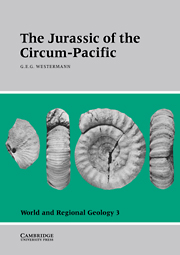Book contents
- Frontmatter
- Contents
- List of contributors
- Preface
- Acknowledgments
- Introduction
- Part I Time scales
- Part II Circum-Pacific base map
- Part III Regional geology and stratigraphy
- Part IV Biochronology
- Part V Biogeography
- 18 Macroflora of eastern Asia and other circum-Pacific areas
- 19 Ostracods and foraminifers of Western Interior North America
- 20 Ostracods of China
- 21 Corals of the circum-Pacific region
- 22 Brachiopods of the circum-Pacific region
- 23 Belemnites of the circum-Pacific region
- 24 Ammonites of the circum-Pacific region
- 25 Fishes of the circum-Pacific region
- 26 Marine reptiles of the circum-Pacific region
- Part VI Climatology and oceanography
- Appendix: Biochronology and atlas with index and guide fossils
- General Index
- Index of Guide- and Indexfossils
20 - Ostracods of China
Published online by Cambridge University Press: 04 August 2010
- Frontmatter
- Contents
- List of contributors
- Preface
- Acknowledgments
- Introduction
- Part I Time scales
- Part II Circum-Pacific base map
- Part III Regional geology and stratigraphy
- Part IV Biochronology
- Part V Biogeography
- 18 Macroflora of eastern Asia and other circum-Pacific areas
- 19 Ostracods and foraminifers of Western Interior North America
- 20 Ostracods of China
- 21 Corals of the circum-Pacific region
- 22 Brachiopods of the circum-Pacific region
- 23 Belemnites of the circum-Pacific region
- 24 Ammonites of the circum-Pacific region
- 25 Fishes of the circum-Pacific region
- 26 Marine reptiles of the circum-Pacific region
- Part VI Climatology and oceanography
- Appendix: Biochronology and atlas with index and guide fossils
- General Index
- Index of Guide- and Indexfossils
Summary
Most of the Jurassic ostracod faunas known to date from many regions of China are nonmarine. The majority of species are endemic, and the assemblages are characterized by high abundance and low diversity. Only a few meager and “marginal” marine ostracod assemblages have been reported from a few areas. The main utility of ostracods is therefore in elucidating the environment of deposition, whereas their role as time indicators is more limited.
Part of the Early Jurassic ostracod faunas are characterized by a Naevicythere-Darwinula assemblage, indicating estuarine conditions for regions of southwestern China and the provinces of Hunan and Guangxi. To the west and toward the northeastern Burmese border the darwinulids are more frequently associated with species questionably assigned to the genus Gomphocythere – a mixture indicating somewhat greater freshwater influences. This latter assemblage has been reported from the provinces of Yunnan, Sichuan, Guizhou, Hunan, Jiangxi, and Guangdong. Species of both Naevicythere and Gomphocythere are indigenous to these regions, as are most of the darwinulids. Some of the Darwinula species, however, seem to be related to, or even identical with, cosmopolitan species. The specific and generic compositions of both assemblages point to freshwater or brackish influences in general terms only, so that detailed environmental reconstructions have to be based on associated flora and fauna and geological considerations.
The distinction between marine and nonmarine ostracod assemblages is more pronounced in the Middle Jurassic. The Schuleridea triebeli–Monoceratina vulsa association of western Yunnan is undoubtedly marine.
- Type
- Chapter
- Information
- The Jurassic of the Circum-Pacific , pp. 322 - 323Publisher: Cambridge University PressPrint publication year: 1993



